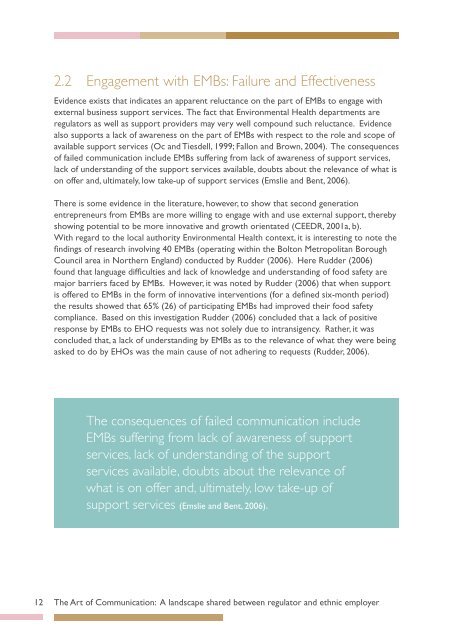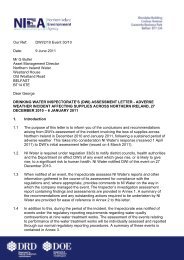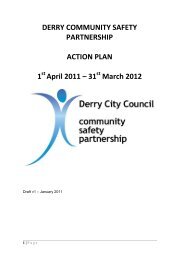The Art of Communication: - Derry City Council
The Art of Communication: - Derry City Council
The Art of Communication: - Derry City Council
Create successful ePaper yourself
Turn your PDF publications into a flip-book with our unique Google optimized e-Paper software.
2.2 Engagement with EMBs: Failure and EffectivenessEvidence exists that indicates an apparent reluctance on the part <strong>of</strong> EMBs to engage withexternal business support services. <strong>The</strong> fact that Environmental Health departments areregulators as well as support providers may very well compound such reluctance. Evidencealso supports a lack <strong>of</strong> awareness on the part <strong>of</strong> EMBs with respect to the role and scope <strong>of</strong>available support services (Oc and Tiesdell, 1999; Fallon and Brown, 2004). <strong>The</strong> consequences<strong>of</strong> failed communication include EMBs suffering from lack <strong>of</strong> awareness <strong>of</strong> support services,lack <strong>of</strong> understanding <strong>of</strong> the support services available, doubts about the relevance <strong>of</strong> what ison <strong>of</strong>fer and, ultimately, low take-up <strong>of</strong> support services (Emslie and Bent, 2006).<strong>The</strong>re is some evidence in the literature, however, to show that second generationentrepreneurs from EMBs are more willing to engage with and use external support, therebyshowing potential to be more innovative and growth orientated (CEEDR, 2001a, b).With regard to the local authority Environmental Health context, it is interesting to note thefindings <strong>of</strong> research involving 40 EMBs (operating within the Bolton Metropolitan Borough<strong>Council</strong> area in Northern England) conducted by Rudder (2006). Here Rudder (2006)found that language difficulties and lack <strong>of</strong> knowledge and understanding <strong>of</strong> food safety aremajor barriers faced by EMBs. However, it was noted by Rudder (2006) that when supportis <strong>of</strong>fered to EMBs in the form <strong>of</strong> innovative interventions (for a defined six-month period)the results showed that 65% (26) <strong>of</strong> participating EMBs had improved their food safetycompliance. Based on this investigation Rudder (2006) concluded that a lack <strong>of</strong> positiveresponse by EMBs to EHO requests was not solely due to intransigency. Rather, it wasconcluded that, a lack <strong>of</strong> understanding by EMBs as to the relevance <strong>of</strong> what they were beingasked to do by EHOs was the main cause <strong>of</strong> not adhering to requests (Rudder, 2006).<strong>The</strong> consequences <strong>of</strong> failed communication includeEMBs suffering from lack <strong>of</strong> awareness <strong>of</strong> supportservices, lack <strong>of</strong> understanding <strong>of</strong> the supportservices available, doubts about the relevance <strong>of</strong>what is on <strong>of</strong>fer and, ultimately, low take-up <strong>of</strong>support services (Emslie and Bent, 2006).12<strong>The</strong> <strong>Art</strong> <strong>of</strong> <strong>Communication</strong>: A landscape shared between regulator and ethnic employer
















